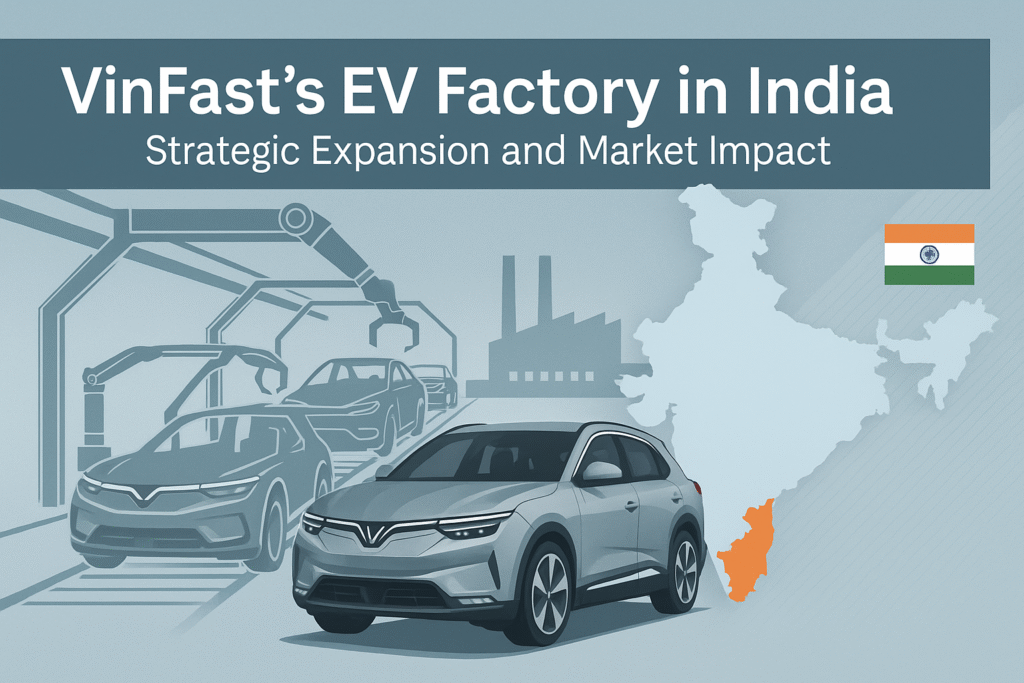
In a pivotal move to expand its global footprint, VinFast—Vietnam’s leading electric vehicle (EV) manufacturer—has officially commenced operations at its first overseas manufacturing facility in Thoothukudi, Tamil Nadu. The August 2025 inauguration of the plant marks a strategic milestone not only for the company but also for India’s emerging position in the global EV supply chain.
Operational Overview: A Scalable Manufacturing Base in Tamil Nadu
VinFast broke ground on the Thoothukudi site in early 2024, with an investment commitment of up to USD 2 billion, including an initial USD 500 million disbursed over the first five years. The facility spans 400 acres and currently operates as a completely knocked down (CKD) assembly plant. Initial production has focused on the VF 6 and VF 7 electric SUVs, with a capacity of 50,000 units annually. Plans are in place to expand this to 150,000 units depending on market demand.
Tamil Nadu—already a key hub for India’s automotive sector—has provided the necessary infrastructure and government support to accelerate VinFast’s local integration. The plant is expected to create 3,000 to 3,500 direct jobs and support a broader network of suppliers and logistics providers in the region.
Ecosystem Development and Strategic Partnerships
VinFast’s entry into India is accompanied by a wider effort to establish a comprehensive EV ecosystem. The company has signed a memorandum of understanding with myTVS to develop a nationwide service network comprising 120 extended service workshops. This ensures localized after-sales support—an essential requirement for building long-term brand equity and consumer confidence in a market traditionally cautious toward new entrants.
Further reinforcing its sustainability credentials, VinFast has partnered with BatX Energies to facilitate battery recycling and rare-earth metal recovery. This collaboration aims to address one of the most pressing challenges in EV adoption: battery lifecycle management and circular material utilization.
Competitive Dynamics in the Indian EV Market
India’s EV sector, while still in its early growth phase, has demonstrated strong upward momentum. In 2024, passenger EV sales crossed the 110,000-unit threshold, a significant increase from fewer than 2,000 units just five years earlier. While homegrown brands such as Tata Motors and Mahindra maintain first-mover advantage, the segment is rapidly evolving with increased competition from global players including MG, Hyundai, and Tesla.
VinFast’s competitive positioning benefits from multiple strategic factors: a localized manufacturing base that reduces import duties, alignment with the Indian government’s “Make in India” initiative, and a relatively neutral geopolitical profile, especially compared to Chinese automakers facing regulatory and consumer resistance.
Importantly, India’s production-linked incentive (PLI) schemes and state-level EV policies provide further tailwinds. The government aims to increase EV penetration to 30% of total passenger vehicle sales by 2030, reinforcing the long-term growth potential of the segment.
Challenges and Brand Development Strategy
Despite a favorable policy environment, VinFast faces the typical market-entry challenges encountered by international OEMs. These include consumer education, building brand recognition, and ensuring robust after-sales infrastructure across diverse geographies.
VinFast has outlined plans to establish 32 showrooms in 27 cities across India, with the first few retail sites, including Surat, already operational. However, long-term success will hinge on factors such as pricing competitiveness, product quality, localized supply chains, and consistency in customer service.
The company must also address differences in consumer behavior. Indian buyers remain highly value-sensitive, and total cost of ownership—factoring in servicing, resale value, and charging infrastructure—will be critical to influencing purchase decisions.
India as a Strategic Export Hub
VinFast’s investment in India is not limited to domestic demand. The Thoothukudi facility is well-positioned to serve as a regional export base. With direct access to port infrastructure, the plant will support vehicle shipments to South Asia, the Middle East, and select African markets.
Initial export orders have already been confirmed from countries such as Nepal, Mauritius, and Sri Lanka. This reinforces VinFast’s broader strategy to pivot towards high-growth, developing markets in Asia and the Global South—particularly as competition and regulatory headwinds intensify in mature Western markets.
Conclusion: A Calculated Expansion with Regional Implications
VinFast’s operational launch in India reflects a measured, long-term strategic play rather than an opportunistic foray. By aligning with Indian industrial policy, investing in local employment, developing a supporting EV ecosystem, and positioning the plant for exports, VinFast is making a deliberate effort to become a regional automotive player.
For B2B stakeholders—ranging from component suppliers and logistics providers to battery recyclers and retail partners—the company’s entry creates new opportunities for collaboration, capacity expansion, and supply chain integration. As India cements its role in the EV value chain, VinFast’s success or failure in this market will serve as a bellwether for future entrants and policy architects alike.

